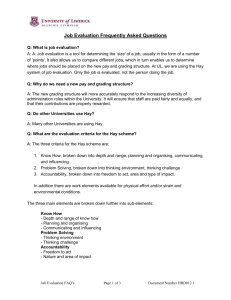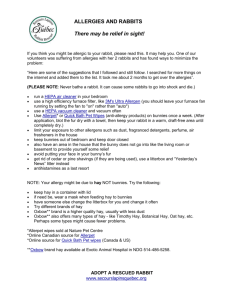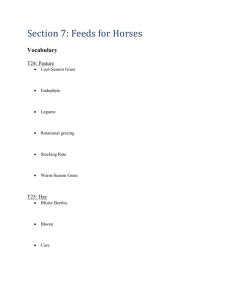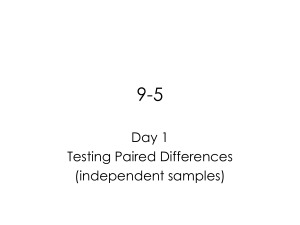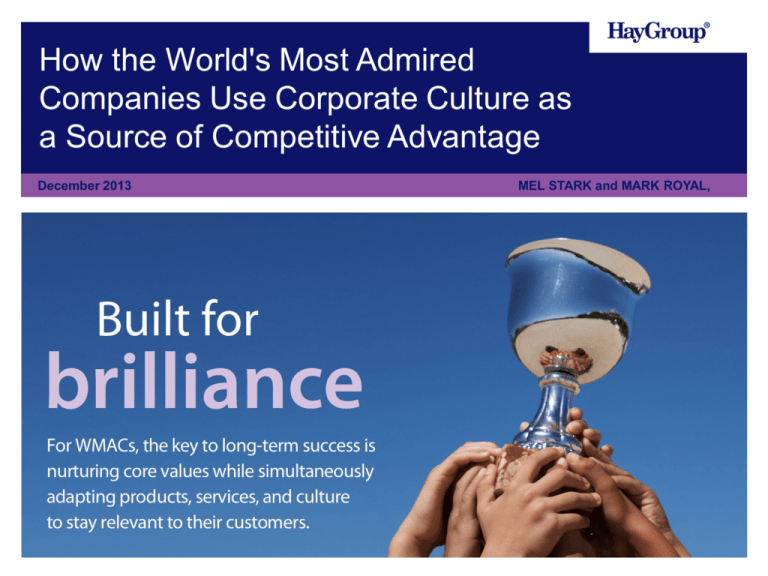
How the World's Most Admired
Companies Use Corporate Culture as
a Source of Competitive Advantage
December 2013
MEL STARK and MARK ROYAL,
Contents
01
Methodology and results
02
Culture and the World’s Most Admired Companies
03
Culture comparisons: Most Admired vs. peers
04
Summary
© 2013 Hay Group. All rights reserved
1
01
Methodology and results
FORTUNE survey of
World’s Most Admired Companies
What is it?
Annual rankings of reputation conducted by FORTUNE magazine and Hay Group
Candidate companies:
FORTUNE 1,000
Non-US Global 500
Companies
companies with revenues of
$10 billion or more
Companies rated both overall and relative to their industry peers by executives,
directors and analysts
Approximately 700 companies
from 30 countries were surveyed
© 2013 Hay Group. All rights reserved
Industry rankings generated for
57 industries
3
Determination of industry rankings
Raters are asked to assess each eligible company in their industry on
each of nine attributes:
01 Ability to attract and retain talented people
02 Quality of management
03 Quality of products or services
HR Focus
Areas
04 Innovativeness
05 Long-term investment value
06 Financial soundness
07 Wise use of corporate assets
08 Social responsibility
09 Effectiveness in conducting business globally
© 2013 Hay Group. All rights reserved
4
Determination of overall ‘All Stars’
Raters are also asked to identify
the ten companies they admire
most (regardless of industry) from
a list of the highest scoring
companies from the previous year
© 2013 Hay Group. All rights reserved
5
‘All Stars’ for 2013
INCLUDES RANKING FROM 2012
01
Apple (1)
11
General Electric (15)
02
Google (2)
12
McDonald’s (11)
03
Amazon.com (3)
13
American Express (16)
04
Coca-Cola (4)
14
BMW (14)
05
Starbucks (8)
15
Procter & Gamble (9)
06
IBM (5)
16
Nordstrom (21)
07
Southwest Airlines (10)
17
Microsoft (17)
08
Berkshire Hathaway (7)
18
Nike (26)
09
Walt Disney (13)
19
Whole Foods Market (28)
10
FedEx (6)
20
Caterpillar (19)
© 2013 Hay Group. All rights reserved
6
WMAC leaders: Top 20 across HR focus
areas
INCLUDES RANKING FROM 2012
01
Apple (1)
11
Walt Disney (3)
02
Qualcomm (9)
12
Nestlé (14)
03
Exxon Mobil (35)
13
Nike (23)
04
Royal Dutch Shell (not ranked)
14
Caterpillar (16)
05
Amazon.com (11)
15
J.P. Morgan Chase (46)
06
Google (8)
16
Deere (26)
07
Whole Foods Market (17)
17
VF (37)
08
Nordstrom (19)
18
American Express (36)
09
Marriott International (not ranked)
19
Boeing (not ranked)
10
Starbucks (18)
20
Colgate-Palmolive (44)
© 2013 Hay Group. All rights reserved
7
The value of reputation
WMACs outperform industry peers and the market as a whole*
Total shareholder returns
WMAC
S&P 500
One year
19.5%
16.0%
Three years
14.4%
10.9%
Five years
6.7%
1.7%
Ten years
12.0%
7.1%
* Note: Average total shareholder returns for the WMAC global top 50 All Stars versus the S&P 500
© 2013 Hay Group. All rights reserved
8
Key differentiators of
World’s Most Admired Companies
Focus of past research
Board governance and
human capital management
Strategy implementation
Organizational design and
operating model effectiveness
Culture
Leadership
Execution
What distinguishes
the ‘best’
Ability to attract and
retain talent
Employee engagement
and enablement
Performance management
Reward program effectiveness
© 2013 Hay Group. All rights reserved
from the rest?
Effectiveness in
conducting business globally
Managing through
economic uncertainty
Innovation
9
02
Culture and the World’s Most
Admired Companies
Brands + Culture = Success
The World's Most Admired Companies: Built for Brilliance
− Geoff Colvin, Fortune Senior Editor, March 18, 2013
“Success in today's economy seems volatile, momentary, evanescent. It's tempting to
conclude that nothing lasts very long anymore. Yet that clearly isn't right; two of this
year's top 10, Coca-Cola and IBM, are over 100 years old. The more accurate
conclusion is that nothing today lasts very long without constant attention…
Everything in your company today will become obsolete with shocking speed if not
obsessively managed. So a critical question for business leaders now is how to manage
in that environment – specifically, what must be managed for change, and what must be
managed for continuity, if we're to be admired in 30 years?
The answer seems clear. Products, services, and strategies must be managed for
change, faster all the time. Their life expectancies are shrinking. Brand and culture
must be managed for continuity. Look at the three old-timers on today's list: Coke,
IBM, and Disney. They possess arguably the strongest brands on earth, and all have
titanium-strength cultures.”
© 2013 Hay Group. All rights reserved
11
Findings from the research
Key points
Culture is seen as a competitive advantage
CEOs and leadership play an active role in nurturing culture to preserve the value of
culture as a competitive advantage over time
The WMACs have learned to balance the tension between ‘continuity’ and ‘adaptability’
in their corporate cultures
− The World’s Most Admired Companies have figured out how to nurture core values
and culture for the long-term…
− While continuing to evolve their cultures to stay relevant to their markets,
customers, and employees
© 2013 Hay Group. All rights reserved
12
Culture
© 2013 Hay Group. All rights reserved
13
Culture: Three interdependent webs of
meaning
Three elements of culture
Organization
purpose and
meaning
Fields of anthropology
and philosophy
The collective and symbolic fabric
of meaning through which people
interpret their experience and guide
their action
Point
of shared
meaning
Field of sociology
The form that action
typically takes
The pattern of social
and power interaction
© 2013 Hay Group. All rights reserved
People
relationships
and networks
Individuals’
motives and
values
Field of psychology
The core goal-state,
wants and needs
people usually strive
to reach and satisfy
14
Culture as
competitive
advantage
How important is culture?
Most Admired Companies agree that corporate culture is a source of
competitive advantage
However, more than half the companies surveyed also believe they need to change their
cultures to respond to changing market conditions
Our corporate culture gives us a significant
advantage relative to our competitors
Changing market conditions are forcing us to
change our corporate culture
0
© 2013 Hay Group. All rights reserved
20
40
60
80
% Strongly agree/agree
100
16
Culture as competitive advantage
“IBM has never defined itself by what it sold. We’ve defined ourselves as
a consequence of our character and our culture. We believe it’s
important to understand with clarity what it is about our company that
won’t change – that’s our character.”
− Senior executive, IBM
What IBMers value:
Dedication to every client’s success
Innovation that matters – for our company and for the world
Trust and personal responsibility in all relationships
IBM is #6 on the World’s Most Admired Companies ranking
© 2013 Hay Group. All rights reserved
17
The role of
CEOs in shaping
culture
CEOs help to shape culture
“Muhtar Kent [CEO of Coca-Cola] is very direct, very pragmatic, and
reinforces the same message to all of us about our behaviors: be
constructively discontent, faster, stronger, more entrepreneurial, and
innovative. It’s because our customers and consumers ask for it – it’s a
business imperative. He’s been very overt about what we need to
change, and do it in a way that preserves our values.”
− Senior executive, The Coca-Cola Company
Coca-Cola’s values:
Leadership: The courage to shape a better
future
Collaboration: Leverage collective genius
Integrity: Be real
Accountability: If it is to be, it's up to me
Passion: Committed in heart and mind
Diversity: As inclusive as our brands
Quality: What we do, we do well
Coca-Cola is #4 on the World’s Most Admired Companies ranking
© 2013 Hay Group. All rights reserved
19
Do CEOs pay attention to culture?
Most Admired Companies report that their CEOs purposefully serve as
role models to shape culture
In addition, the Most Admired say that corrective action would be taken for leaders who
fail to uphold corporate values
Our CEO purposefully acts as a role model to
shape the desired culture of this organization
If a senior leader failed to adhere to corporate
values, corrective action would be quickly taken
0
© 2013 Hay Group. All rights reserved
20
40
60
80
% Strongly agree/agree
100
20
CEOs help to shape culture
“Role modeling of senior leadership is incredibly important. Ginni
Rometty [CEO of IBM] has helped us see the connection between culture
and business results. She is asserting that we will achieve better
business results through a more engaged employee base. That has
reaffirmed culture as a differentiating factor for the company and how it
can drive revenue growth and expand business on a daily basis. Ginni
reenergized the topic of culture and character, put her own imprint on it,
and has kept it on the agenda for everyone here.”
− Senior executive, IBM
IBM is #6 on the World’s Most Admired Companies ranking
© 2013 Hay Group. All rights reserved
21
CEOs help to shape culture
“Carlos Rodriguez [CEO of ADP] is an active driver of culture. He says
talent is one of the top three priorities for him. He leads from the front.
He challenges himself and his direct reports in terms of both substantive
results and behaviors. It’s critical that the organization sees that we line
up our financial capital with the human capital. A belief system must be
role- modeled and coached from the CEO.”
− Senior executive, ADP
ADP’s values:
Integrity is everything
Each person counts
Insightful Expertise
Results-driven
Service Excellence
Social responsibility
Inspiring Innovation
ADP is #1 Most Admired in Financial Data Services
© 2013 Hay Group. All rights reserved
22
Shaping culture
in global
companies
Freedom within a framework
Coca-Cola has more than 140,000 employees in over 200 countries
“We have freedom within a framework. Though we are a global company, we are also a
local business across over 200 countries. We have adapted policies and workplace
practices that consider the global framework but that are relevant at the local level.
We onboard employees all over the world every day to both the Company globally and
what is important to know locally. Our leaders are part of the onboarding process,
reinforcing the values and heritage that make Coca-Cola uniquely us.
We want to ensure that all of our employees experience brand love and our core values
consistently around the world.”
− Senior executive, The Coca-Cola Company
© 2013 Hay Group. All rights reserved
24
How do Most Admired Companies
‘nurture’ their cultures?
Performance management and formal onboarding processes are most
frequently used to reinforce culture in the Most Admired Companies
However, from an employee ‘lifecycle management’ approach, it appears that many may
be missing an opportunity to influence culture ‘early’ in the cycle through recruiting and
selection
Our recruiting and selection process formally
tests new hires for 'fit' with our corporate culture
New employees are formally educated on our
corporate culture in induction/onboarding
processes
Culture and values are formally incorporated
into our employee performance management
process
0
© 2013 Hay Group. All rights reserved
20
40
60
80
% Strongly agree/agree
100
25
Testing for culture fit
ADP is a company that has been growing through acquisitions, needing
to integrate culture
“We are creating greater rigor to have more alignment in our culture. It used to be up to
a local unit to figure out integration. Now, we do culture fit assessments and integration
right away and will move talent to other parts of ADP to increase success.
We can test for culture – for example, we look at sales compensation plans and ask,
“Do they care about the team?” ADP is a team-oriented culture. We can tell just by
looking at their compensation programs if they would be difficult to integrate, and, if so,
the deal would be quickly taken off the table.
We look at delivering for client needs, financial results, and do they fit the values of ADP
– how they treat their employees.”
− Senior executive, ADP
© 2013 Hay Group. All rights reserved
26
How are HR practices used to
shape culture?
Most Admired Companies report they are less frequently using culture
and values in reward and recognition decisions, compared to
performance management and promotion decisions
Culture and values are formally incorporated into
our employee performance management
process
Culture and values are explicitly evaluated in
reward and recognition decisions
Corporate culture and values are formally used
in making promotion decisions
0
© 2013 Hay Group. All rights reserved
20
40
60
80
% Strongly agree/agree
100
27
The role of the front line manager
IBM is a company where more than 50 per cent of the employees have
been with the company for less than 5 years
“We emphasize the role of the front line manager. For the employee, that first line
manager represents IBM. So we need to equip the first line manager to set the right
example, know the company history, know the culture, and have the teachable moments
with employees. This is important, particularly when most IBM employees don’t work in
an IBM office. Globally, more than 40% of IBM employees work from a client site or at
home on any given day.”
− Senior executive, IBM
© 2013 Hay Group. All rights reserved
28
Extending
culture to
external
stakeholders
Is corporate culture reinforced with
external stakeholders?
Although we see companies communicating their culture and values as
part of their brand, the use of culture and values as a screening device
for suppliers is still an emerging practice
Our corporate culture and values are actively
communicated externally to the market as part of
our brand
Our corporate culture and values are used to
select and manage our suppliers
Our corporate culture is actively communicated
and reinforced with our customers
0
© 2013 Hay Group. All rights reserved
20
40
60
80
% Strongly agree/agree
100
30
Extending culture and values to suppliers
Coca-Cola uses Supplier Guiding Principles (SGP) to communicate its
values and expectations of suppliers
“We have very strong guiding principles for all our suppliers around the world. We have
high standards that we audit: human rights, work place rights, ethics, compliance, how
you do business. It’s our accountability and reflects upon our brand and we want to work
with our suppliers and partners in that shared vision of success.”
− Senior executive, The Coca-Cola Company
© 2013 Hay Group. All rights reserved
31
03
Culture comparisons:
Most Admired vs. peers
Culture in Most Admired Companies
evolve over time
IBM
“Historically, we have learned to focus on the core things that should not change. Part of
our business model is being willing to change everything. We have come to see change
as a norm.”
− Senior executive, IBM
© 2013 Hay Group. All rights reserved
33
Organizational culture assessment
Follow up research
Hay Group invited companies to complete its Organizational Culture Assessment (OCA)
instrument
− The OCA consists of 40 questions that identify 20 attributes of culture
− Respondents complete the questionnaire twice: once to identify the ‘current’ culture
and a second time to identify the ‘future’ desired culture
Data were then analyzed to compare and contrast results from the Most Admired
Companies and peer companies
© 2013 Hay Group. All rights reserved
34
Current cultures
The top-ranked attributes of the current cultures for both Most Admired
Companies and peer companies are very similar
Current cultures
Quality
Values
Ethics
Customer focus
Social responsibility
Focus on competitors
Fair treatment
Valuing outside resources
Long-term horizon
Most
Admired
Peer
0.0
© 2013 Hay Group. All rights reserved
1.0
2.0
3.0
4.0
5.0
6.0
7.0
35
Desired cultures
Differences appear between the top-ranked culture attributes for the
Most Admired Companies compared to peer companies
Most Admired Companies place a larger emphasis on core values and customer needs
Desired cultures
Values
Customer focus
Quality
Ethics
Fair treatment
Long-term horizon
Individual autonomy
Focus on competitors
Inclusive decision making
Most
Admired
Peer
0.0
© 2013 Hay Group. All rights reserved
1.0
2.0
3.0
4.0
5.0
6.0
7.0
36
How do the Most Admired Companies
evolve their cultures?
Coca-Cola
“The consistency of our culture comes from core values: how we treat each other, how
we lead in the market, how we work with our consumers, our customers, and our local
communities. Those are things we hold true to. It’s like our DNA. We say when we see a
Coke person, ‘They bleed ‘red’.’
On the flip side, we need to be constructively discontent. We learned we need to change
to stay relevant to our consumers. Our customers are always looking for innovation, for
us to add value to the partnership. We need to continually meet the demands of our
customers.
That is the art and science: how to protect our core values and at the same time let go
of what we need to, to be faster, nimbler.”
− Senior executive, The Coca-Cola Company
© 2013 Hay Group. All rights reserved
37
Culture change comparison
Differences in emphasis between Most Admired Companies and peer
companies on cultural attributes for the future
Differences in focus: WMACs vs. peer companies
Values
Inclusive decision making
Customer focus
Breadth
Individual autonomy
Long-term horizon
Fair treatment
Risk tolerance
Innovation
-1.5
© 2013 Hay Group. All rights reserved
Greater focus
for Most Admired
Companies
Greater focus for
peer companies
-1.0
-0.5
0.0
0.5
1.0
1.5
38
Balancing the past and the future
ADP
“We need to shift our culture to enable future performance. But the soul of the company
is what you take with you, even as you pivot your business. We are shifting our model
from being a ‘leader in payroll’ to being a ‘leader in human capital management.’ This
implies a different culture is needed, different skill sets. But we need to shift without
disrupting our rich history.”
− Senior executive, ADP
© 2013 Hay Group. All rights reserved
39
04
Summary
Findings from the research
Key points
Culture is seen as a competitive advantage
CEOs and leadership play an active role in nurturing culture to preserve the value of
culture as a competitive advantage over time
The WMACs have learned to balance the tension between ‘continuity’ and ‘adaptability’
in their corporate cultures
− The World’s Most Admired Companies have figured out how to nurture core values
and culture for the long-term…
− While continuing to evolve their cultures to stay relevant to their markets,
customers, and employees
© 2013 Hay Group. All rights reserved
41
Levers for culture change
Shared
purpose
and values
Guided by
Inspiration, history,
purpose, mental models
of founders and leaders
Dominant individuals’
and leaders’ motives
and values
Relationships and
networks
Dominant country
environment
Organizational
messages and
reinforcements
Driven by
Aspiration
Strategy and goals
Leaders’ posture and
role modeling
Organization structure
design
Organizational capability
Management systems
Brand
Symbols and artifacts
Actions
and behaviors
Short and
long term
engagement
and results
Delivered by
Leaders’ behaviors
Employees’ engagement
and behaviors
The key is to identify and
focus on the relevant
catalysts for change
© 2013 Hay Group. All rights reserved
42
Contact us…
Visit our website
www.haygroup.com/fortune
Contact us
Mel Stark
Hay Group in New York
mel.stark@haygroup.com
Mark Royal
Hay Group in Chicago
mark.royal@haygroup.com
© 2013 Hay Group. All rights reserved
43
Questions?
© 2013 Hay Group. All rights reserved
44


